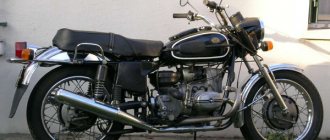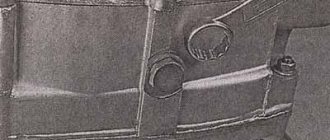Moto Stunt Riding is a modern type of extreme motor sport, developing at a rapid pace among those who are already bored with regular riding according to the rules.
The emergence of this sport has even led to the creation of separate companies that produce uniforms for motorcycles, special protective equipment, etc. As one would expect, this type of motorsports has become widespread in the United States, where young professionals appear every year, masterfully demonstrating tricks of varying complexity .
In Russia, motorcycle stunt riding is just beginning to emerge and is supported only through the efforts of a small number of enthusiasts. Stunt riding specialists are able to make a real show out of several tricks. At the heart of the show is the thirst for adrenaline, the desire to try something new.
Stunt riders have the hard work of honing their skills behind them. In order to master a trick of medium difficulty, months of hard training are required. Some elements take years to complete.
At this time, three styles have emerged in stunt riding:
- American - characterized by an abundance of acrobatic elements.
- European - the technique of performing tricks comes first.
- Japanese – has elements of European and American driving styles.
By the way, the first European Championship was held in 1997, and a year later the World Championship took place. Gradually they are starting to make entire films about stunt riding, both documentaries and feature films, which easily find their audience.
Key features of stunt riding
The basic principle of training is that quantity gradually turns into quality. Each trick should be given a lot of attention. Everything consists of smaller elements that should be worked out gradually.
The peculiarity of stunt riding is that it is impossible to master a trick without falling once . Therefore, the morbidity of this sport is off the charts.
You should not perform stunts on city streets in traffic. This, at a minimum, leads to violation of traffic rules, and at a maximum – to the creation of an emergency situation and falls. In addition, if a trick has not been brought to automaticity, it is better to postpone demonstrating it to others until all the elements have been fully mastered. There are a lot of videos of unsuccessful stunts.
All tricks should be practiced on a motorcycle that has good handling and relatively light weight. If you fall from such a bike, you are less likely to suffer serious injuries.
Buell XB12S
What would it be like to combine modern innovative technical solutions with a two-cylinder fork? Erik Buell wanted to check this out and did. He was probably the only one crazy enough to put a Sportster engine into something that not even the great Japanese four think about to this day. The Buell XB series was the icing on a cake that, unfortunately, had already been eaten. The XB12S was less than 7cm long, compact, even compact. Due to the power of the two thundering cylinders generating enormous torque, it was rarely seen with both wheels touching the ground.
Basic stunt riding tricks
- Rear tire annealing or burnout.
- Riding on the rear wheel (wheelie).
- Stopping on the front wheel (stoppie) or riding on it.
- Movement with the rear wheel slipping (drift).
- Driving in a circle without the rear wheel.
- Riding a motorcycle while sitting on a gas tank.
The most dangerous tricks include stoppies. Once a high angle has been set, there is every chance that the motorcycle will not be able to return to its original position. In addition, the slightest movement of the steering wheel can also lead to a fall.
To perform stunts, the maximum possible protection is necessary, which should not only protect the motorcyclist from injury, but also not hinder movement.
How is motorcycle drift useful?
Once you master a movement like drifting, you can get much more pleasure from driving your motorcycle. In addition to new emotions, you gain an invaluable skill that can be useful to you in a difficult situation. Very often it happens that a motorcyclist does not have time to slow down before a turn, as a result of which he simply does not get into it. Some people get out of the situation by adding gas, others, due to inexperience, on the contrary, brake and turn at the same time, which should not be done at all. As a result, the rear wheel breaks off and the motorcycle falls. Such a technique as drift allows the motorcyclist to get out of the current situation. Of course, you shouldn’t think that by learning how to skid on a motorcycle you will be able to navigate any turn. If the speed is too high, then anything can happen. But still, it’s worth learning, if only for the sake of new emotions and impressions.
Motorcycle requirements
One of the main requirements for a motorcycle is the absence of plastic. The bike must be suitable for the stuntman in weight. People with low body weight will find it more difficult to control a heavy motorcycle.
A stand-up motorcycle must be lightweight, have reliable suspension and a powerful engine. Regular stock wheels are not suitable for performing tricks. The best option is to replace them with spoked or cast ones.
By and large, the choice of tires depends on what kind of tricks the motorcyclist plans to perform. Spoke wheels are not suitable for burn out because they are tubeless and do not allow the rubber to be completely burned. Cast wheels are not strong enough, so doing all possible jumps on them is contraindicated.
To start learning stunt riding, almost any motorcycle with average performance that does not require major changes is suitable. As skill increases, the requirements for the vehicle grow, so all kinds of replacements of units and components are carried out.
Honda CRF450 (...and every big capacity enduro)
Larger capacity hardcore enduros are a bit pointless. Nowadays, the world is moving towards downsizing and manufacturers are making their motorcycles more comfortable and easier to use. Equipment like the Honda CRF450 or KTM EXC530 are Tasmanian devils. Wild and rough machines that intimidate even people who are damn good at riding dirt bikes. There is probably no need to examine the relationship between mass and power here. These devices just want to ride on one wheel. In any case, what to expect from motorcycles weighing 110-120 kg and producing 60 hp?
Which motorcycle to choose for stunt riding?
The most popular motorcycles for stunt riding have been and remain sports, with one condition that the plastic fairings are removed from them. Here are some of the most popular models:
- Honda CBR 600F4i.
- Yamaha YZF R6.
- Kawasaki ZX636 Ninja.
- Suzuki GSXR600.
- Honda CBR929/954.
A classic option for a stunt. An excellent option for beginners. It has a strong frame and subframe, so no additional reinforcement is required. Equipped with a reliable engine. The disadvantage is the weight, more than that of the main competitors, and obsolescence.
Equipped with a powerful motor. It has good traction at low revs, is light and controllable. The disadvantage is the weak subframe.
Not suitable for beginners as it will not survive many falls. Very light and controllable, has good traction in low gears. There are no problems with oil starvation. The engine and frame are inferior in reliability to the Honda CBR 600F4i.
The engine is very playful and reliable, the technical characteristics are good. The main disadvantage is the weak frame, so it is not used as often as its main competitors.
A good option for learning. Affordable price. Reliable engine and frame. The disadvantage is the weight, maneuverability is worse than that of competitors, and it has difficulties with control at low speeds.
QUESTION PRICE
Looking ahead, I’ll tell you what awaits you and your bike. As in all motorsports disciplines, there will be more than one fall and more than one bruise. And the motorcycle will have to be repaired several times more often than you did before. Worn sliders, footrests, broken levers, bent handlebars, crumpled gas tanks, bent rims, replacing tires once a week, or even more often, oil starvation and a broken engine - These are not all the troubles. To solve at least some of the problems, you will have to take care of the equipment and protecting the motorcycle from damage. We also need to think about improving the motorcycle to make it easier to perform stunts. A lot of technical questions arise. If this doesn’t scare you, welcome to the stunters.
Tire tread
In stunt riding, as on the race track, the grip of the motorcycle with the road surface is very important. Yes, warm tires increase your chances of success. But the less pattern and moisture-wicking channels there are in the tread, the more comfortable it will be to perform. Extreme riders have found that the rear tire can be left on a regular street pattern and the front tire can be fitted with a slick. We read about motorcycle tires in the article “Types of motorcycle tire treads. Classifications". Of course, tires for sports motorcycles wear out at wild speeds, and after drifting they literally melt before our eyes, but beauty, sport and skill require sacrifice.
In the next article we will look at more advanced innovations that are necessary for an experienced stunt rider.
Willie (Wheelie).
One of the basic stunt riding tricks that everyone who has ever sat on a motorcycle has tried to do. Even if this motorcycle is the Carpathians, and everyone around him calls the “Willy” trick a term that is much more understandable to the Russian ear: “Zakozlit”. Wheelie is a trick that involves riding a motorcycle on one rear wheel.
When performing this trick, the motorcycle engine experiences oil starvation (except for options with a dry sump), so professional stunt riders first modify the lubrication system of their motorcycles before performing tricks. Occasionally, at a traffic light, you can go crazy without any alterations. Any motorcycle allows you to do a wheelie, either from the gas, when the gear to the second gas is abruptly closed, the motorcycle nods, the fork compresses and then, simultaneously with the fork unclamping, the gas sharply opens. Almost any motorcycle with an engine capacity above 400 cc can be pulled off the gas without any problems, so a similar trick is accessible to most ordinary motorcyclists. On weak technique, or for individual cases of Willie, lifting from the clutch is used. In this case, the motorcycle operates at high speeds, and the torque is controlled by the clutch lever. In this case, the clutch wears out much faster, but the owner immediately receives the respect of the boys and the love of beautiful ladies. Stunters usually just install huge driven stars that pull the motorcycle off the gas in any case.
However, for motocross riders and endurists, the basic Wheelie is not a trick at all, but an ordinary element of everyday motorcycle riding. Stuntriders make it many times more difficult, performing it while sitting on the tank with legs to the sides, on the steering wheel, standing on one leg, etc. Besides, it’s one thing to go around at speed or jump over some obstacles on the rear wheel while moving, and quite another thing to balance in a Wheelie at almost zero speed.
Much more complex tricks are already based on Willy. Let's look at some of them.
Various stunt riding tricks, during which the motorcycle rides on one rear wheel, and the rider performs some kind of manipulation with his legs and arms.
Highcare is a stuntrider trick in which the rider sits feet first on the gas tank of a motorcycle during a wheelie. Like in a high chair
50/50 or Special k wheelie - a trick during which the rider throws one leg over the crossbar of the motorcycle.
Can Can, Crossover, Flamingo wheelie - tricks during which the rider, standing on one footpeg, throws one leg forward and back, or stands on the pegs with his legs crossed, or takes one leg out back, respectively.
Champion, Frog wheelie and Watch tower. The champion rider does a wheelie with one arm, the other extended upward. Frog wheelie - The rider squats on the gas tank or crossbar of the motorcycle during the wheelie. Watch Tower - the rider stands on the traverse.
1.2. Foot drag, Hand drag, Scrape.
A set of stunt tricks in which, during a wheelie, the ground is touched with a foot, hand, or the rear part of a motorcycle subframe. In the latter case, the motorcycle goes far beyond the balance point, that is, it falls back at an angle of more than 90 degrees.
https://youtube.com/watch?v=VtUTq7FdZaA
1.3. Table (Stall), Stand, Wheelie park.
Tricks during which the rider stops to zero speed while remaining in a wheelie.
1.4. Switchback wheelie (switchback wheelie), Superman (Superman table).
Tricks that do not fall under the gradation indicated in the previous subparagraphs. In the first case, the rider performs a wheelie while sitting or standing on the motorcycle backwards.
When performing the second trick, the rider pushes off the ground with his feet and momentarily hovers over the motorcycle parallel to the ground, resembling Superman.
Replacing the steering wheel and yoke
Traditionally, stuntriders choose to replace the handlebars with clip-ons (“Clip-ons on a motorcycle, when are they needed?”) or a motocross handlebar. There is a strong opinion that it is more convenient to ride with a cross steering wheel, while performing tricks is easier with clip-ons.
There is another logical consequence in this. Clip-ons are easier to replace after many falls. By the way, after the same falls, the brilliant idea comes to remove the headlight. It’s a shame to brush the asphalt with it, and there’s no point in using it if you’re not going to show off somersaults on public roads at night.
THE CORRECT "STUNT PERFORMER"
I warn you in advance: he scares away the fair sex, since it is not always possible to keep him in a state of candy.
How to prepare the bike? Start by installing the crossbar. There are several options. Let me make it clear right away: the cross steering wheel is not for everyone, and this is not a necessary part of the changes. For example, representatives of the American school of stunt riding widely use clip-ons. But if a motocross steering wheel is more convenient for you, then here are the options: a) Buy brackets for the steering wheel and drill holes for them in the “original” traverse. This is an option for the cheap: when it breaks, you have to pay twice. b) Buy a traverse or just a kit with a steering wheel, additional cables and brake hoses. c) Make a traverse with brackets for the steering wheel in a workshop at a local “Kulibin”.
We change the brake hoses to reinforced ones, remove the “tidy” and the entire front fairing (if you plan to drive around the city, I recommend an endura “face” with a couple of “minions”). We install the steering damper and radial front brake master cylinder (photo 1). These are not all the changes to the front of the motorcycle, but they are enough for stunt riding. If you are ready to move on, then continue improving the bike by replacing the fork with an inverted one, installing progressive springs and petal brake discs. An important point is the adjustment of the front suspension (fork): it needs to be made stiffer by replacing the springs or at least increasing the preload. This will help avoid “breakdowns” of the fork after a wheelie and during stoppies. Slightly “tighten” the suspension rebound. To avoid breaking them, it is better to saw off the brake and clutch levers so that they remain under two fingers - the index and middle. Such modifications, again, are a budget option.
Take care to protect the engine and plastic (whoever still has it). In America, there are several companies that produce protection in the form of so-called “cages” - they allow you to keep the plastic, engine and driver’s footrests intact in the event of a fall. If you have time and money, the design can be ordered through a specialized store; it will cost approximately $300–400 (including delivery). The “cage” can also be made in the workshop of the same “Kulibin”. As a rule, several mounting points for the bushings on the frame are selected, and they are connected to each other with 25-30 mm pipes (photo 2, 3).
An important part for stunt riding is the final drive ratio. Stock up on a set of sprockets - driving (front) and driven (on the rear wheel). American stunt riders recommend adding 20 teeth to the stock rear sprocket. You can experiment by reducing one or a couple of teeth on the front sprocket. I do not recommend installing a drive sprocket that is too small; it increases the load on the chain. Leading stars can be selected from catalogs; trailing stars are more difficult to find. The way out is to go to “Kulibin”.
Plastic and protection
The first thing any proper stunt rider does is remove excess plastic and put on maximum protection. Among motorcyclists, who falls more often than a novice stunt performer? Come on, surprise me? The plastic can be left, used as space for advertising your blog or as tuning. But after the first couple of hundred falls, you’ll wonder if plastic is needed at all? Mirrors are also in the firebox. The pro trains on special grounds. Functionally, mirrors are not needed there, and even if they fall, they break like crazy.
Different levels of protection are installed on the motorcycle, which saves on repairing the engine and other vulnerable components. At first it seems that such a set of armor protection is too wasteful a gift, but when you start calculating the amount of repairs without it, and then converting it into our wooden rubles. you silently agree to the price of protection. We discussed it in the article (“Protective bars, safety cages and sliders on a motorcycle”).
The engine protection cage must dissipate impact forces without risking damage to the frame, so it is better to choose cages with the maximum number of fasteners.
Stuntriders choose engine cages, as well as an additional subframe stiffening frame and protection for the tail of the motorcycle, which is important in tricks with the tail touching the asphalt or when falling on its side. You don't have to have everything, but a combination of several solutions is worth considering.
Subcage - an arched structure of the tail section, which has side steps, is installed as an additional frame of rigidity for the subframe.
The round bar is also an arched tail protection that encircles the tail of the motorcycle and protects it when the tail touches the asphalt. If you see sparks flying at such moments, then most likely it is not plastic, but a round bar.
A yoke is a frame, which is sometimes called a “mop”, “brush” and other associations. It is beneficial to install it not only as protection for the tail section, but also as additional support. The yoke allows you to place the motorcycle vertically; due to its U-shape, it will be stable. It is also used as a support for the rider’s legs while performing a trick.
Hint: many people completely forget about radiator protection. The bottom line is that due to frequent landings on the front wheel from the top point, the radiator mounts wear out faster. The likelihood that these fasteners at one not-so-great moment will decide to eject and throw the radiator overboard is quite real, therefore, in order not to tempt fate and not increase the cost of repairs, it is better to take care of the fasteners in advance.
It is useful for a beginner to install a circuit protector. Simply, if you fall frequently, your feet or clothing may get caught in the moving parts of the motorcycle. It seems like a small thing, but the toes often slip off.
Slow ride
Let us immediately note that riding a motorcycle slowly is much more difficult than riding a motorcycle quickly. This is due to the fact that at low speed it is more problematic to maintain balance. In addition, you need to get the hang of reacting to the behavior of the bike by squeezing the clutch or adding gas. After all, driving very slowly with the clutch lever fully released will not work; the engine will stall. Conversely, if you fully depress the clutch, the engine torque will not be transmitted to the wheels.
It is necessary to find and feel the optimal combination of clutch lever and throttle position. The engine must run stably, and the motorcycle must move very slowly. The gas and clutch in this exercise must be considered as a whole. To reduce speed, you can either let off the gas or squeeze the clutch a little harder. This exercise is designed to bring the combination of clutch and gas to automaticity. The pilot must squeeze the clutch and turn the gas intuitively. And don’t be afraid that you’ll burn the clutch. On most bikes, the clutch discs are in an oil bath, and it is almost impossible to burn them.
To perform this exercise correctly, you need to find an empty area or parking lot with a normal asphalt surface. Next you need to measure the length of 33.5 meters. You need to drive along a straight line at a minimum speed. The slower the better. It is necessary to select such a position of the clutch lever and throttle handle so that the engine speed is stable, and at the same time the motorcycle rides at a minimum speed. When driving slowly, try not to look down and to the sides. The head should be raised and looking forward. It is necessary to maintain balance with the help of the vestibular apparatus, and to stay on the line is necessary through lateral vision. If you manage to drive slowly and smoothly, then you need to try to reduce the speed further. To do this, select a new clutch and gas combination. It is necessary to constantly reduce the speed and do this gradually. There is no need to try to go as slowly as possible the first time. The main goal of this exercise is to learn to feel the gas and clutch.
You need to do the “Slow Riding” exercise for 20 minutes, three times a week. After 1-2 months, you need to reduce your speed to such an extent that you will travel a distance of 33.5 meters in 20 seconds or more. If you have achieved this result and feel confident in this type of riding, then you can reduce the number of classes to once a month.
This exercise is best done before or after a trip. If you don’t succeed the first time, don’t give up. You need to have patience. This is much more complicated than it seems at first glance. It takes a lot of effort to master slow driving to perfection.











